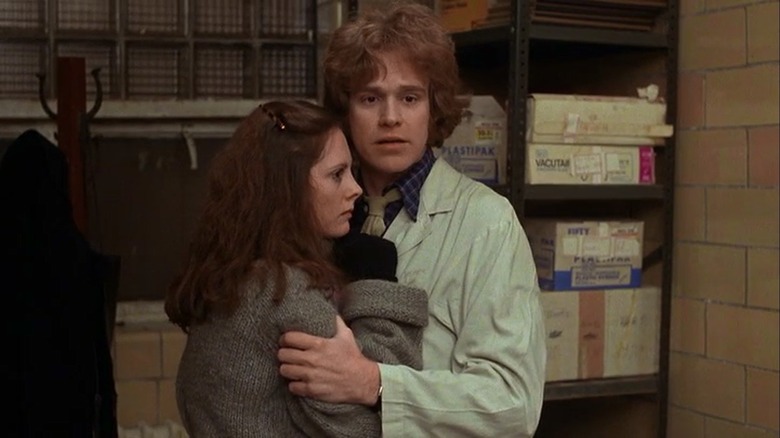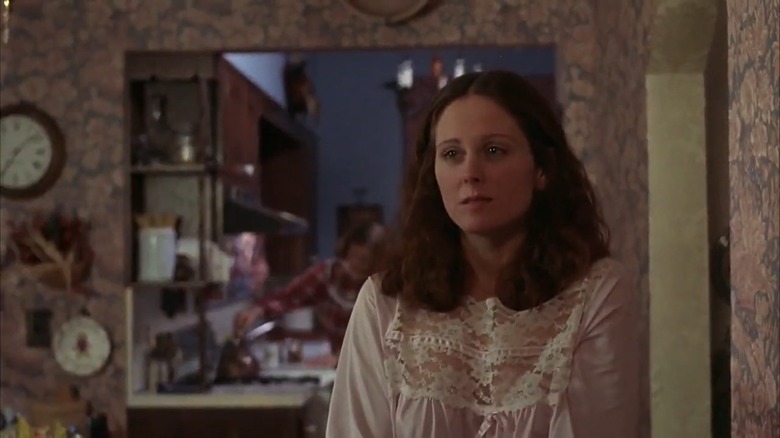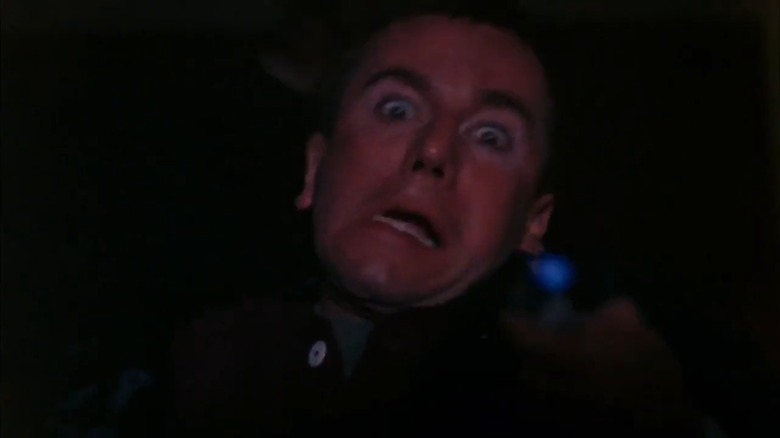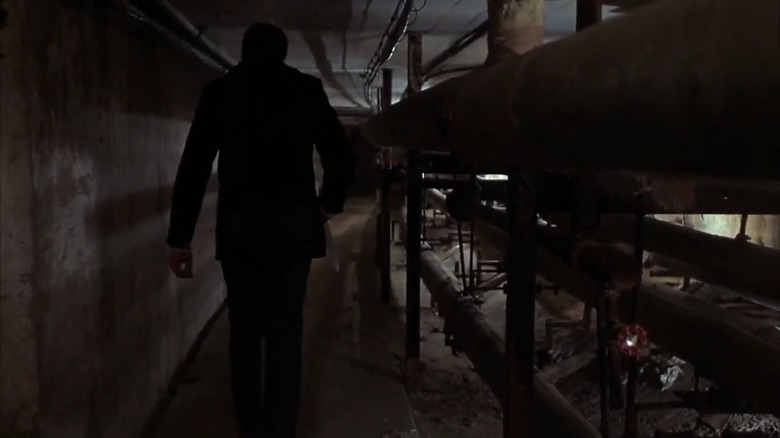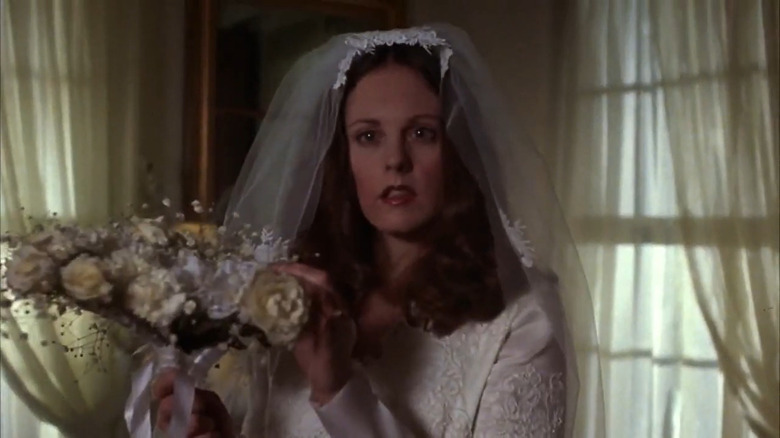The Forgotten '80s Slasher He Knows You're Alone Will Have You Checking Your Surroundings
Armand Mastroianni's 1980 "He Knows You're Alone" might have borrowed a number of shots from John Carpenter's 1978 film "Halloween." It might have drawn from that movie's score, and it might have conceived of its unstoppable villain in a similar way. But it doesn't deserve to be left in the margins of the '80s slasher movie boom, especially given that it isn't a lesser entry in the genre.
Despite the movie being a decent-sized hit at the time of its release, grossing nearly $5 million per BoxOfficeMojo, it has largely been forgotten, outside of an early Tom Hanks appearance as a jogger. Compared to the best-known entries in the slasher subgenre of horror, there wasn't any kind of easy iconography to get absorbed into mainstream pop culture. Its relatively low budget means that there's fairly limited coverage and occasional bits of technical cost-cutting. But there's a strong sense of dread throughout, as well as visual and narrative ideas that are fairly forward-thinking, especially for a simple serial killer thriller. There's even a kind of grimy realism to the movie – not in its violent scenes, but in its most low-key moments, complemented by autumnal earth tones.
The big thing that differentiates it from "Halloween" is that it doesn't have any of the Michael Myers childhood psychological disturbances, nor any psychiatric doctor insisting the villain has "the devil's eyes." In "He Knows You're Alone," we don't know too much about the killer to start with, except that his victims are all brides or brides-to-be. That includes the wife of the cop Len Gamble (Lewis Arlt) who excitedly takes the case when he realizes the killer is back.
Halloween-esque staging
Of course, the "Halloween" similarities are most significant when it comes to the staging. This is a movie that loves revealing a character is being stalked, that somewhere in the background the villain has been waiting for them to move so they can reveal themselves.
The movie also has a chilling opening sequence, not going for the Steadicam POV of the "Halloween" cold open but for something that would come to look like inspiration for "Scream 2": a killing in a movie theater as characters watch a horror movie. The victim? A woman some weeks away from getting married. As Len Gamble hears the news, he realizes it's the man who killed his wife on their wedding day, a moment shown to the viewer in soft-focus flashbacks.
Another bride-to-be, college student Amy (Caitlin O'Heaney) is closing in on her impending marriage with trepidation — she's actually in love with her kind of irritating ex Marvin (Don Scardino). She's susceptible to horror movie paranoia, even during what should be the happiest time of her life. One of many great dread-inducing moments that could have been ripped from "Halloween" is when she looks at a storefront television video of herself. The second that she moves away from it, we see she's been watched by the killer, Ray Carlton (Tom Rolfing).
What makes the movie really work is its low-key looks at women's friendships and sexual desire, as well as its cozy sense of Staten Island suburban misery. Rather than steep the movie in explicit dread the whole way through, there are a number of lighthearted scenes that flesh out the characters. Amy's friend Joyce (Patsy Pease) for instance, is having an affair with the philosophy professor Carl Mason (James Rebhorn), and it seems to be going well.
Kills
Luckily, we know there's a killer on the loose so there's tension underneath even the lightest moments. Director Armand Mastroianni takes this principle as far as it can go in the scene when Joyce is finally made to pay for her affair, as in the moralistic tradition of the slasher movie genre. The back-and-forth flirting of Joyce and her professor as they wrestle with whether or not to continue the fling is undergirded by our knowledge of the killer and his predilections — there's no way the movie would waste time on something like this without giving viewers a big moment.
Still, the kills in "He Knows You're Alone" are largely unsatisfying, for whatever that's worth. There's a great sense of buildup throughout the scene, as the professor continually checks the house for noises. They're afraid his wife is back, we're afraid for what we know is coming. When the power cuts out, things become especially nerve-wracking. But as the scene reaches its end, with Joyce unresponsive in bed as Carl assures her everything is okay, his getting stabbed by Ray happens so quickly and with so little fanfare it's hard to be shocked or terrified at the moment. That said, Tom Rolfing's stabbing face, lit by his cigarette lighter, is perfect for the jump scare.
Another underplayed killing is the death of Amy's dressmaker as she's trying on her wedding gown. As effective as the suspense generated by the buildup is, with the voyeuristic framing on Amy lasting a long time, the ultimate payoff is minimal. But Amy knows she's being stalked, and it's beginning to have an effect. She can barely summon interest in her fiancée.
Into the morgue
Elliot (Tom Hanks) is also there to explain away some psychological facets, as a Psych undergrad who is relentlessly hitting on Amy's friend Nancy (Elizabeth Kemp). Amy's paranoia is good fodder for Elliot's know-it-all shtick, but his and Nancy's obvious chemistry means that danger is afoot. This is a slasher after all, and these are sexually active young adults.
For as much as Elliot talks about the psychological impulse behind people being afraid to take showers after watching Alfred Hitchcock's controversial "Psycho," you would think Nancy would take the hint when she takes a shower of her own. Her post-shower routine of smoking and relaxing to easy-listening music leaves her extremely vulnerable. Again, the killing is fairly underplayed, to a degree that you might assume the producers had wanted to skimp out on blood effects. Amy's discovery of Nancy's head in the fish tank makes it worthwhile.
That's the final moment before she comes face to face with Ray. It's a thrilling setpiece that makes up for the anticlimactic killings throughout, moving from Amy's home to her car to the morgue where Marvin works. Marvin's insistence that nobody is trying to kill her is immediately undercut by the arrival of the man who's trying to kill her. Meanwhile, Len Gamble is on his way to help, and to get vengeance for his wife.
The shallow focus photography of the chase through the morgue makes for some of Mastroianni's finest work in the film, and where previous scenes made use of a more mundane kind of tension, the morgue scene is all narrow corridors, dim lighting, Ray's knife hanging low and ready to be used.
Wedding
Marvin and Amy are able to escape Ray at the morgue and ultimately end up getting married themselves. In perhaps the most obvious final twist of all time, as Amy gets ready for the ceremony (alone on account of all of her friends being dead), the scene is shot in the exact same sensual soft-focus style employed for the flashback of Ray's first murder. She sees her ex-fiancée in the room, and we're led to believe the cycle begins anew.
"He Knows You're Alone" was, like many horror movies of the '80s, fairly demeaned by critics who went so far as to call it "sickening trash," as Kevin Thomas of the Los Angeles Times did. It was as if the glut of low-budget and violent, exploitative horror movies made critics of the genre more willing to dismiss any work on its individual merits. While the movie itself isn't necessarily at the level of more iconic pieces in the genre, it still has plenty of excellent attributes. And plenty of bad ones. But for a slasher shot in a little over two weeks per Adam Rockoff's slasher history "Going to Pieces," it holds up.
It's easy to imagine watching it in a theater like the characters in the beginning, reacting extremely to every big jump scare, clutching popcorn tight at every moment of dread. And the sense of paranoia throughout it is exquisitely rendered, even more impressive when considering the obvious constraints. It's an underrated slasher that deserves a look.
